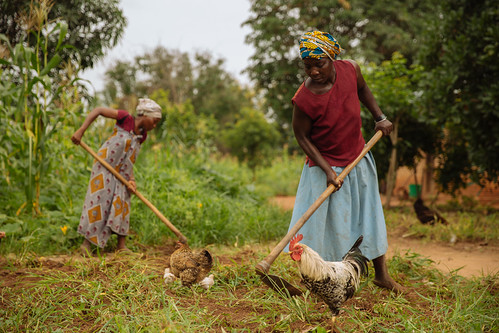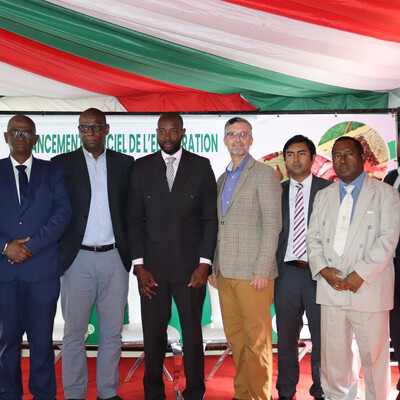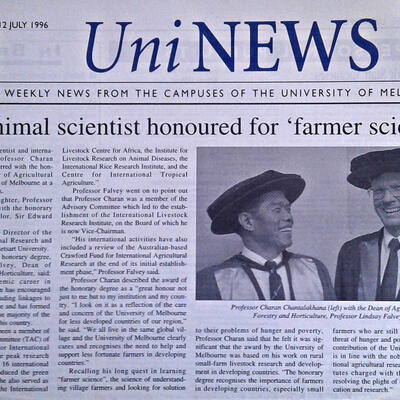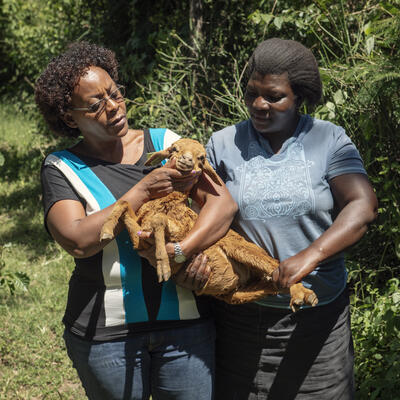
ACGG Tanzania baseline data report now available

Women farmers work the land with chicken around, in Kilosa, Tanzania (photo credit: Mitchell Maher / International Food Policy Research Institute).
The African Chicken Genetic Gains (ACGG) project conducted a baseline survey in 2015-2016 across ACGG countries (Ethiopia, Nigeria and Tanzania) to understand, define and characterize the current smallholder chicken production system, chicken ecotypes, current productivity, husbandry practices, farmer production objectives and socio-economic status of smallholder chicken keepers. This post introduces the Tanzania baseline report.
The baseline survey was conducted in 80 rural villages of Tanzania. Random study villages from different agro-ecologies were selected in the central semi-arid, eastern subhumid, southern highlands, lake, and southern humid zones (described in the project as ‘subnational zones’). The study covered 1,202 households. Following a description of the survey design and tools, the study presents the main findings including rank-index, tables, and graphs.
Key baseline results
General profile:
- Only 239 (20.6%) of the sampled households were female-headed.
- The average number of years of schooling, family size and age of the household head was 6.9, 5.2, and 47.8, respectively.
Poultry development and strain trait preferences:
- The mean chicken flock size per household was 27 chickens.
- Ninety-four per cent (94%) of households had experience of providing supplementary feeding (i.e. any feed that was not scavenged) to their chickens at any time of the year.
- The preferred traits for good cockerels were good physical appearance, large body size, and less illness.
- The single preferred trait for good hens was the production of more eggs
- Chickens are kept for multiple purposes, with meat consumption and live adult chicken sale rated highest.
Income and ownership:
- The average quarterly household income from all sources was low in eastern subhumid sone (TZS 237,803, about USD105) and highest in lake zone (TZS 476,890).
- The overall average quarterly income of households from all sources was about TZS 352,654 .
- The contribution of poultry income to total household income was 38.35%.
- Seventy-nine per cent (79%) of households said crop farming their major source of livelihood, followed by livestock keeping and poultry keeping.
- Chickens were owned by males or females or jointly, but the most common livestock ownership pattern was joint ownership.
- Men owned more farm and household assets, although joint ownership was significantly higher than individually-owned assets.
- Livestock amounts to 15-58% of total household assets.
Food and nutrition security:
- Respondents reported that they had enough food in the last 12 months (respectively for 98% in southern humid zone; 91% in lake zone; 91% in southern highlands, 85% in eastern subhumid zone and 79% in central semi-arid zone.
- Overall, 89% of the respondents reported that they had adequate food in the last 12 months for their household.
- Most households in the project subnational zones have acceptable Food Consumption Scores (FCS) of more than 35.
- The dietary diversity score indicated was found to be higher for children than for men and women.
Chicken and egg consumption (in the three months leading up to the survey):
- Chicken consumption is highest in lake zone (4.3 birds per quarter), followed by central semi-arid (3.3 birds per quarter), and it is lowest in southern highlands zone (2.0 birds).
- The general average across zones shows households consumed on average 3 birds per 3 months.
- Egg consumption was high in southern highlands (19.2 eggs per quarter) and low in lake zone (8 eggs per quarter). Average egg consumption across zones was 14.6 eggs per 3 months.
Labour allocation:
- Adult women spend, on average, 138 minutes per week for chicken activities (about 20 min/day).
- Adult men, at 46 minutes per week (7 min/day), spend more time than children and hired labour.
- Fifty-four per cent (54%) of households reported that money accrued from sale of chickens was used for covering household basic needs.
The information generated from the baseline survey informed the design and implementation of the longitudinal (on-farm) study. It is also hoped that the information generated in the report can support future chicken research and development activities. In addition, the procedures followed and the baseline tools developed can be adapted for similar purposes outside ACGG sub-national areas. Finally, the data provides a useful reference to study similar cases.
Read the full Tanzania baseline report online: http://hdl.handle.net/10568/97039

















